Indoor hydrangea is an elegant, semi-shrub plant. Interestingly, the color scheme of the inflorescences of the plant can be regulated by monitoring the composition of the soil. So, acidic soil is able to color inflorescences in a bluish tint, neutral earth will give a beige color, and alkali will color the petals pink.
Material Content:
Types and varieties of room hydrangea
Varieties have been developed whose inflorescences are painted in different colors on one bush. The most common in home floriculture are specimens with pink and blue inflorescences. In total, there are currently more than a hundred varieties.
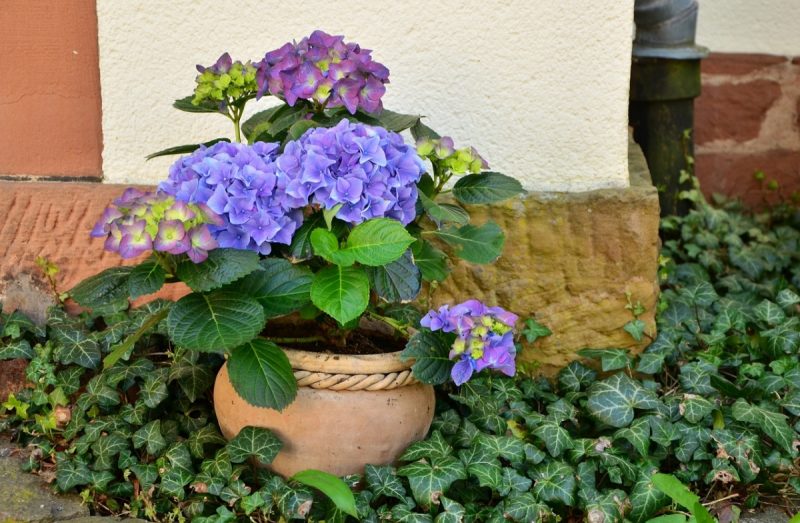
The Airlie Blue variety with blue inflorescences is very popular. Many flower growers grow red hydrangeas of the varieties "Prima", "Red Sensation".
The pink color of the inflorescences are of the varieties "Europe", "Hamburg", "Goliath".
Features of growing flowers
A houseplant hydrangea does not need painstaking care, despite all its exotic origin. Even an inexperienced, beginner grower can cope with the cultivation of this magnificent flower. But nevertheless, it is necessary to strictly observe the rules of care so that hydrangea blooms lushly and continuously.

First of all, you need to monitor the cyclical development. Having ensured a correct wintering of the flower, you can get a lot of buds that have started in the spring.

Indoor hydrangea is a deciduous shrub, and for the winter the flower discards foliage. At this time, the flowerpot is rearranged in a slightly cool place so that the bush can rest. In winter, hydrangeas are watered very poorly and do not feed. The resting period of indoor hydrangeas lasts 2 months. In the spring, the flower begins to grow.
Optimal conditions for content
Hydrangea flower in room conditions does not tolerate the sun at all, but at the same time loves bright light. It is optimal to place the flowerpot next to the southern window, but in no case on the windowsill itself. If you put a bush in the sun, then the plant simply will not bloom.
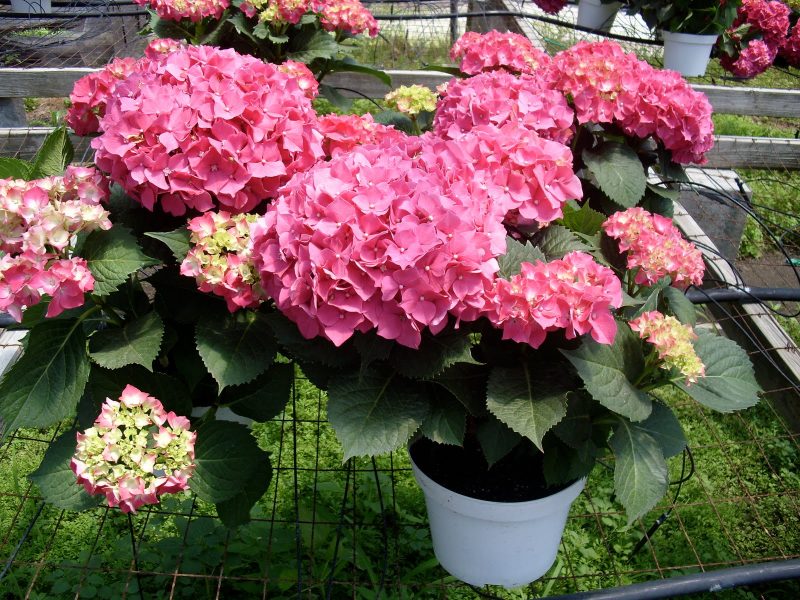
Throughout the year, you can not change the intensity of lighting.
If the daylight hours are reduced even in winter, this can adversely affect the development of the flower - the plant will weaken, become susceptible to disease.
To prolong daylight hours, hydrangea in winter should be clarified.
Hydrangeas love the air. Therefore, the room should be regularly ventilated, but at the same time, be careful that there is no draft. In summer, the bush can be taken out to the balcony.
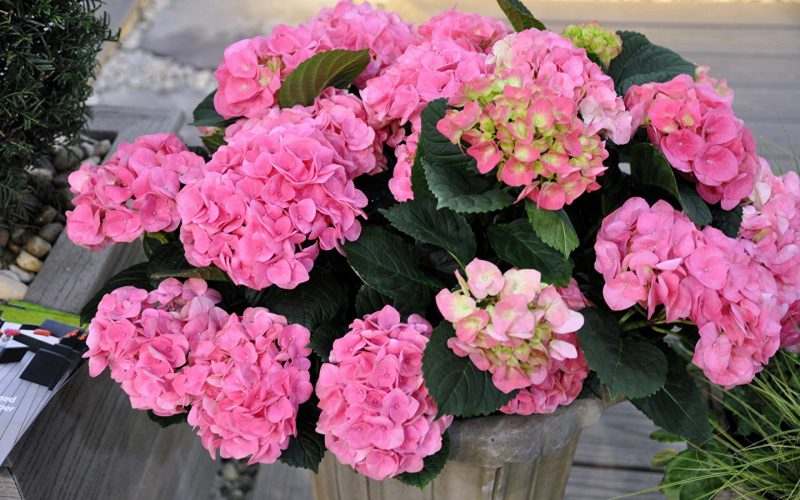
Hydrangea does not like heat, and for many years it will bloom only in a cool room, in which it is not higher than +20. In winter, the flower needs to lower the temperature to +10. Wintering can even be on a glazed loggia.
In the case of wintering on the loggia, the flower shoots should be shortened by 2/3. Cover the plant with spruce branches or special material. If even the shoots of a flower freeze slightly in winter, it will recover very quickly in spring.
If hydrangea is comfortable, then its foliage will be juicy green. If the plant begins to drop foliage, then the room is too hot.

In addition to cool, large-leaved hydrangea is very fond of high humidity. It is advisable to spray the air around the pot every day.
Read also:panicle phantom hydrangea
Home Care
In the summer, the flower should be watered frequently and plentifully. In spring and in autumn, watering should be very moderate. In winter, watering is sharply reduced, making sure that the earthen lump in the pot does not completely dry out. Water for irrigation is well-established. Many gardeners water hydrangeas only with melt water.
It is interesting:Dieffenbachia: home care

In spring and summer, fertilizers are applied every two weeks along with irrigation. For lush flowering hydrangeas are suitable mineral top dressing for indoor flowers.
Pruning plays a very important role when growing a flower. If the shoots are long and weakened, then they must be shortened. Pruning helps form a beautiful crown of the bush. Pruning is carried out twice a year.
In the fall, they form the basis, which will serve as a framework for young shoots. Strong branches are shortened by half, and all thin branches are completely removed. In the spring, only weakened branches are removed.
Propagation of home hydrangea
The easiest way to propagate hydrangea is to split the bush. When a transplant is needed, the bush is divided with a sharp tool into several delenki so that each has shoots and developed roots. First, dividers should be transplanted into small flowerpots, and when the bush grows, transplanted into a spacious pot.
A more laborious way of propagating seed.
It is used mainly by breeders. Hydrangea seeds are propagated at the end of winter, sowing them in prepared containers with suitable soil mixtures. Crops need to be aired, moistened. When a pair of leaves appear on the sprouts, they are planted in small individual pots. The diameter of flowerpots should be about 6-7 cm.
Experienced flower growers plant a flower by cuttings. Do it in February or even in January.
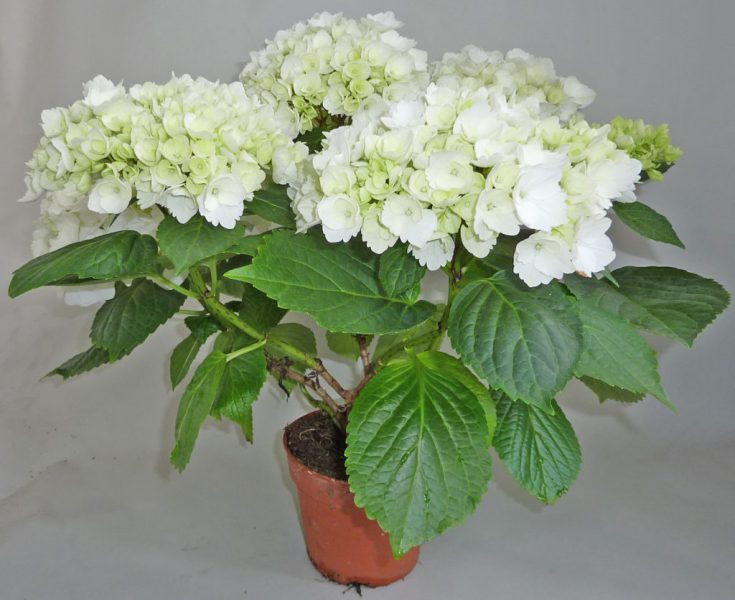
Basal shoots are taken on cuttings. The length of each branch should be about 7-8 cm. On the lower part of the branch, the leaves are removed, and the upper leaves are shortened by 1/3.
Planting cuttings carried out in peat soil. The containers are puffed with film and placed in a warm and bright place. By the autumn, small bushes will develop from the cuttings. Flowering of young plants will come next season. Care for hydrangeas grown from cuttings should be exactly the same as for adult specimens.
Protection against diseases and pests
Diseases and insects can cause significant damage to the flower.For example, if it is watered very often and too abundantly, then this will inevitably lead to the appearance of root rot. In this case, Bordeaux fluid should be used to treat the bush.
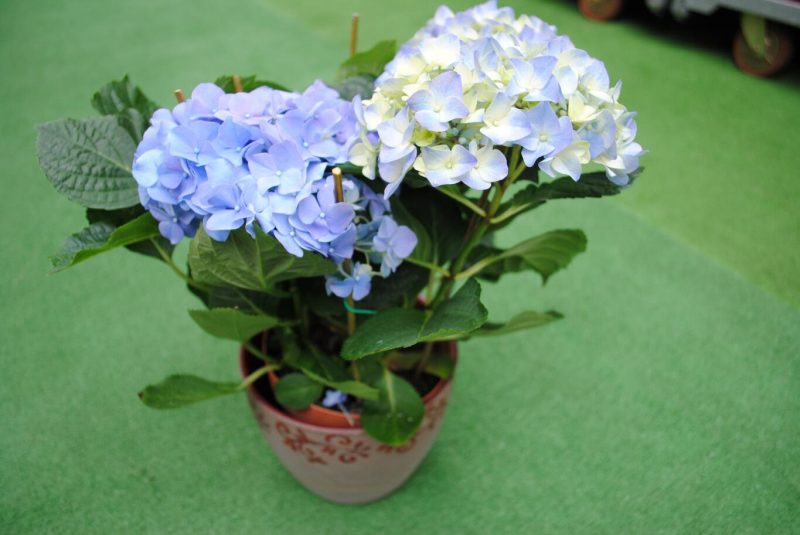
Powdery mildew may develop due to high temperature. Hydrangea leaves dry out due to illness and the flower can die quickly. Copper-based drugs are used to treat the disease.

Dryness also leads to the appearance of a spider mite on the bushes. This pest eats the juice of leaves and stems and weaves the thinnest cobweb. In case of attack of a plant by insects by pests, it must be treated with the “Actellik” preparation.
The main problems when growing in a pot
Most often, when growing, they encounter drying of foliage in hydrangeas. The main reason is dryness. This flower does not tolerate dry air and low humidity.
![]()
If possible, the pot should be placed next to the aquarium or put water containers in the room. It is advisable to spray air to artificially increase humidity.
If the soil is constantly dry, then the flower will also begin to dry the leaves. It is enough to adjust the irrigation mode. And the problem will disappear.
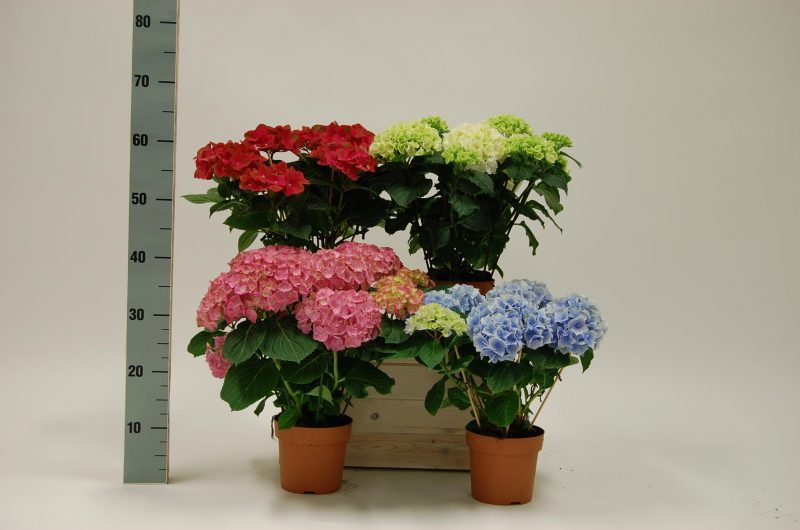
If the flower begins to turn slightly yellow, then most likely the soil in the pot is not acidic enough. You can correct the situation by watering the plant with lemon water, diluting 5 drops of lemon juice in a liter of water.












